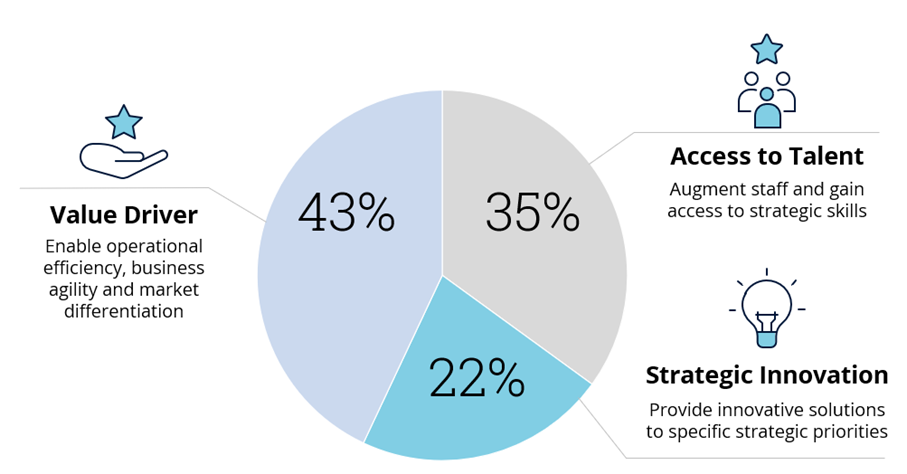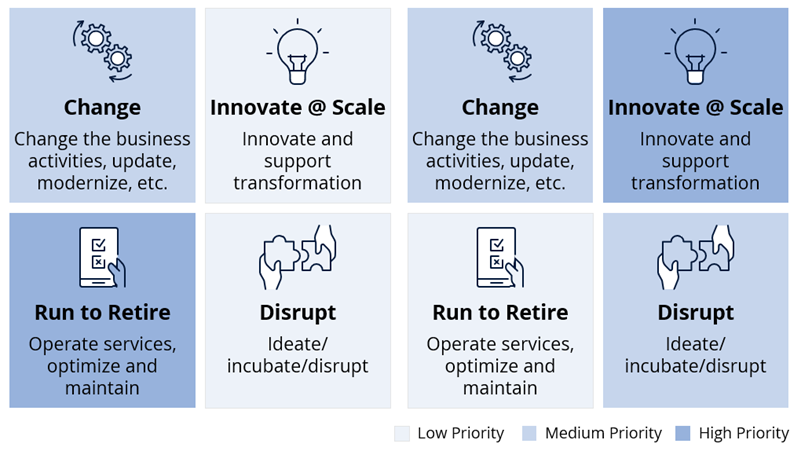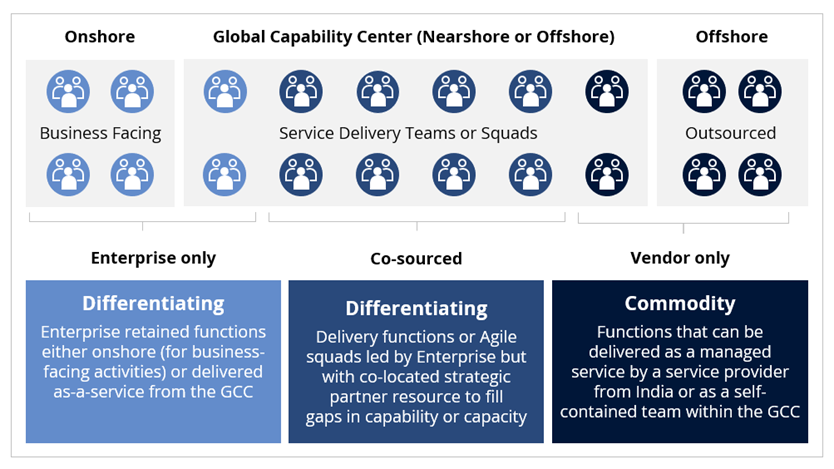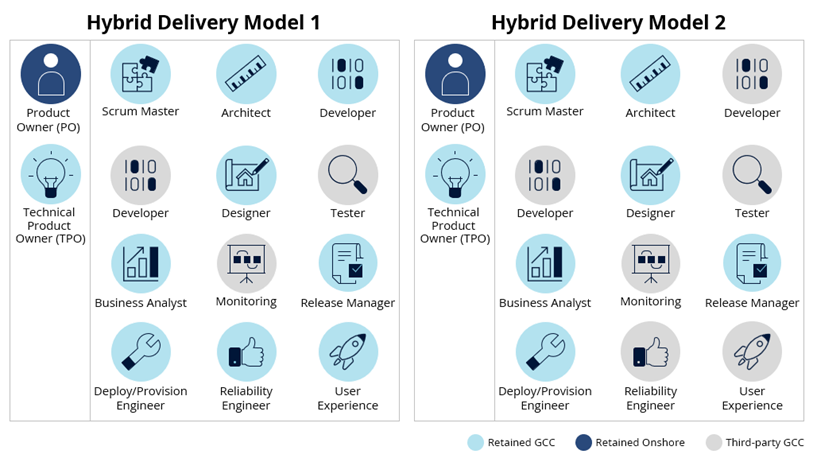Global capability centers (GCC) are hot. Enterprises are finding this form of operating subsidiary that provides services back to the parent organization can bring substantial benefit. According to ISG Research, in the next 24 months, nearly a quarter of enterprises we asked are looking to set up a new GCC and 40% are looking to expand their GCCs.
Why a GCC?
Organizations are looking for ways to access the talent they need to deploy advanced technologies such as generative AI, machine learning, analytics and cloud – and they are looking for ways to deploy them at scale. And, while they’re at it, they need to optimize costs. This means both smart investment and cost take out.
This is why GCCs make sense for certain organizations. It’s a way to balance transformation and cost optimization. We have found that companies investing in GCCs are after three specific outcomes: access to talent, strategic innovation and business value enabler.

Figure 1: Key Strategic Drivers for Establishing a GCC
The Three Strategic Drivers for Establishing and Scaling a GCC
Access to talent: As organizations accelerate their technology and business transformations, they need to attract and retain talent with the skillsets they require, especially in advanced capabilities. With low unemployment in the U.S. and an aging population in Europe, organizations are increasingly recognising the need to establish centers in talent-rich locations, such as India, China, Philippines, Mexico and Brazil, where they can recruit at scale and at a cost point that delivers a viable business case.
Strategic innovation: Recruiting and retaining the right talent can be a powerful antidote lack of innovation. Enterprises need to underpin this talent with technology, platforms and solutions that will catalyze innovation at scale.
Business value enabler: The potential value of a GCC as a strategic asset falls into three discrete categories. First is the value gained from operational efficiency through optimized processes and cost structures. Second is the value resulting from the GCC's agility, enabling the business to quickly adapt to changing market conditions and customer demands. Third is the value derived from higher value-adding retained capabilities, with a focus on enabling business innovation and differentiation.
Unlike traditional captives or global shared service centers focused on labor arbitrage and technology or process optimization, newer GCCs – those established since 2021 – are increasingly being used as innovation hubs, transformation CoEs and centers for emerging technologies.

Figure 2: Evolution of GCC Focus
But, for many enterprises, establishing and scaling a GCC is not as straightforward as they first think. Establishing a GCC often takes far longer and is more complicated than expected. Two of the most common challenges include:
Complexity: Of the key challenges highlighted by enterprises in a recent survey, complexity scored highest, with 34% of respondents scoring this within their top three concerns. Most organizations lack the in-house knowledge and experience needed for a challenge of this scale and complexity.
Lack of talent: ISG Research finds that 31% of enterprises rated retention and attrition as their highest concerns when it comes to establishing a GCC, and 28% highlight challenges around talent recruitment. Enterprises often lack the presence, brand or permissions to attract the talent they need.
Please fill out this form to continue.
Why Organizations Need Strategic Partners for GCC Operations
It is for these reasons that over a third of enterprises now seek support from strategic partners in their GCC operations. The kind of support organizations need differs from the kind needed for traditional managed GCCs – those established and operated on an enterprise’s behalf by a managed service provider with limited oversight from the client – or for traditional build-operate-transfer models used in the past. Today, organizations with mature in-house capabilities and outsourcing services are looking for a more bespoke solution that meets their specific needs. This is resulting in a hybrid delivery model, in which the role of a strategic partner differs from client to client, based on their specific needs.

Figure 3: GCC Capability Model
Organizations will use a capability model, similar to the one above, to take a menu-based approach. It will involve two prongs: 1) identifying the areas they lack capability and capacity and that can be filled by potential partners and, 2) establishing and scaling other capabilities. This will be a hybrid delivery model.
Although an increasing number of enterprises are opting for a hybrid model, it increases the level of complexity requiring additional hand-offs, collaboration and oversight in GCC operations. As the hybrid GCC model matures, organizations will likely face a breakdown of traditional roles and responsibilities, and a blurring of the boundaries between themselves and their strategic partners. This will create a co-sourced model across their technology and business services.

Figure 4: Hybrid GCC Delivery Model
What Is a Hybrid GCC Delivery Model?
Of course, GCCS do not exist in isolation. They are an extension of their existing delivery ecosystem that will continue to deliver onshore in their domestic markets close to the business – and will continue to outsource. Figure 4 highlights both the role that GCCs play in the end-to-end delivery model as well as the collaborative nature of working with partners to deliver differentiated value in a co-sourced, hybrid GCC model.

Figure 5: Example Hybrid Delivery Models
Organizations must continue to prioritize in which capabilities to invest, and this is driving up the popularity of the GCC model.
What should enterprises have in mind when setting up or scaling their GCC operations?
6 Key Considerations when Establishing a GCC
- Create a clear mandate and demand for establishing a GCC: A GCC should have senior sponsorship, a clear mandate to ensure the business understands its purpose and position. When defining the mandate and purpose of a GCC, be sure to quantify the demand for such a capability in the short, medium and long term. The business case for a GCC should not be made based on short-term demand and requirements but should focus on how it will reposition the organization for the future.
- Make sure the business case is financially viable: GCCs typically take time to establish, need significant capital investment, require commitment of both leadership and the wider organization’s time to establish and incur higher costs of exit when compared to traditional outsourcing. Organizations looking to recruit talent within a GCC should expect to pay 20% to 40% higher than those paid by managed service providers (MSPs).
- Ensure realistic scale and scope. There is a minimum operational scale below which running GCC operations is not economical; GCCs need to establish suitable scale to ensure appropriate return on investment.
- Select the right delivery model. When establishing a GCC, an organization needs to assess its priorities and weigh the balance between time, scalability and investment as this will impact the set-up model they choose.

Figure 6: Example Delivery Models
- Invest in experience. As with any new capability, prior experience in building and operating a GCC is essential. In addition to project management skills, the team requires subject matter expertise across the core scope area as well as support and shared services functions. Clients should look to leverage additional 3rd party SME knowledge bridging any gaps in their internal organisation to ensure the successful establishment of the GCC and to guarantee its early success.
- Location! Location! Location! The location of the GCC can be a key contributor to its success in terms of the availability of talent, core local infrastructure and environment and political stability. Give these factors careful consideration.
Assessing location of a GCC requires considering the following options:
- Onshore: This allows a company with business, service or regulatory constraints to tap specialized capabilities with limited scale and scope.
- Nearshore: This allows enterprises to mitigate issues with time difference, language requirements and cultural alignment while enabling work to be conducted inside a specific geography.
- Offshore: Offshore locations such as India have long been popular locations for both outsourcing and GCCs and have the greatest concentration of GCCs globally. With the greatest access to talent, optimal costs and close proximity to strategic partners, many enterprises select offshore locations for establishing their strategic hubs.
Selecting the right delivery model for your GCC is a nuanced and critical decision that organizations must navigate carefully. With a multitude of options available, each presenting its own set of advantages and challenges, it is essential to weigh these choices thoroughly. Key stakeholders need to be educated about these delivery options to facilitate a smooth transition from one model to another, as misalignment can occur if perceptions remain tied to the legacy model during this period.
ISG has successfully guided many organizations through this complex decision-making process, helping them navigate the intricacies of GCC models. Ultimately, with the right approach, organizations can leverage GCCs as powerful assets to achieve their digital transformation objectives while optimizing costs and driving sustainable growth.